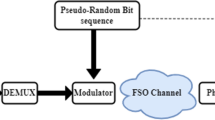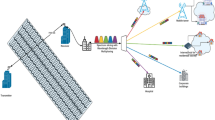Abstract
Over last decades, the free space optics (FSO) emerged as most prominent way of communication over radio frequency communication and microwave communication. The FSO works in the same way optical fiber cable (OFC) network works with the only difference that the optical beams were transmitted through the free space and not by using the OFC core i.e. the glass fiber. The presence of mist, fog, rain and clouds in the atmosphere directly affects the performance of FSO and the power of propagating signal is degraded significantly. Since the wavelength of propagating beam is comparable to size of fog particles, they mainly lead to atmospheric attenuation. To mitigate the impact of atmospheric attenuation on signals, the present study develops a spectrum slicing (SS)-wavelength division multiplexing (WDM) system with Pre and Post Amplification. The performance of the proposed SS-WDM-Pre and SS-WDM-Post scheme is analyzed and then compared with the traditional SS-WDM model in the Opti-system in terms of Q-factor and BER values. The analysis of the proposed and traditional scheme is done under varying attenuation and power signals during summer, winter, autumn and spring season.The comparative analysis proved that the performance of the proposed SS-WDM-Post and SS-WDM-Pre-model is more effective and efficient when compared with the traditional SS-WDM model in terms of Q-Factor and BER during all 4 seasons.












Similar content being viewed by others
References
Aladeloba, A.O., Woolfson, M.S., Phillips, A.J.: WDM FSO network with turbulence accentuated inter-channel crosstalk. IEEE/OSA J. Opt. Commun. Netw. 5(6), 641–651 (2013). https://doi.org/10.1364/JOCN.5.000641
Fadhil, H.A., Amphawan, A., Shamsuddin, H.A.B., Hussein Abd, T., Al-Khafaji, H.M.R., Aljunid, S.A., et al.: Optimization of free space optics parameters: an optimum solution for bad weather conditions. Optik. 124(19), 3969–3973 (2013). https://doi.org/10.1016/j.ijleo.2012.11.059
Garg, N., Singh, V.: Free space optical communication link using optical Mach-Zehnder modulator and analysis at different parameters, In: 2014 International Conference on Issues and Challenges in Intelligent Computing Techniques (ICICT), IEEE, Ghaziabad, India, pp. 192–195 (2014) https://doi.org/10.1109/ICICICT.2014.6781277
Goyal, H., Saxena, J., Dewra, S.: Performance analysis of optical communication system using different channels. Int. J. Adv. Res. Comput. Commun. Eng. (IJARCCE) 4(9), 19–22 (2015). https://doi.org/10.17148/IJARCCE.2015.4905
Khalighi, M.A., Uysal, M.: Survey on free space optical communication: A communication theory perspective. IEEE Commun. Surv. Tutorials. 16(4), 2231–2258 (2014). https://doi.org/10.1109/COMST.2014.2329501
Khan, M.S., Muhammad, S.S., Awan, M.S., Kvicera, V., Grabner, M., Leitgeb, E.: Further results on fog modelling for terrestrial free-space optical link. Optical Eng. 51(3), 031207 (2012). https://doi.org/10.1117/1.OE.51.3.031207
Khan, M. S., Muhammad, S. S., Awan, M. S., Leitgeb, E., Grabner, M., Kvicera, V.: Validating relationship between aerosol's liquid water content and optical attenuation for terrestrial FSO links, In: Proceedings of the 11th International Conference on Telecommunications (ConTEL), Graz, Austria, pp. 195–198 (2011).
Malik, A., Singh, P.: Comparative analysis of point to point FSO system under clear and haze weather conditions. Wireless Pers. Commun. 80(2), 483–492 (2015). https://doi.org/10.1007/s11277-014-2022-6
Nain, H., Jadon, U., Mishra, V.: Evaluation and analysis of non-linear effect in WDM optical network, In: 2016 IEEE International Conference on Recent Trends in Electronics, Information & Communication Technology (RTEICT), IEEE, Bangalore, pp. 36–39 (2016). https://doi.org/10.1109/RTEICT.2016.7807777
Nor, N. A. M., Islam, M. R., Al-Khateeb, W.: Analysis of the effects of environment on the performance of free space earth-to-satellite optical link in Malaysia, In: 2011 IEEE Student Conference on Research and Development, IEEE, Cyberjaya, Malaysia, pp. 235–240 (2011). https://doi.org/10.1109/SCOReD.2011.6148742
Prabu, K., Kumar, D.S., Srinivas, T.: Performance analysis of FSO links under strong atmospheric turbulence conditions using various modulation schemes. Optik 125(19), 5573–5581 (2014). https://doi.org/10.1016/j.ijleo.2014.07.028
Radhi, A.H., Jaiswal, A.K., Kumar, M.: Performance analysis of radio over fiber system with OOK based DWDM for fiber to home network. IOSR J. Electron. Commun. Eng. IOSR-JECE. 8(5), 26–29 (2013)
Rahman, M.T., Iqbal, S., Islam, M.M.: Modeling and performance analysis of free space optical communication system, In: International Conference on Informatics, Electronics & Vision (ICIEV), IEEE, Dhaka, Bangladesh, pp. 211–218 (2012). https://doi.org/10.1109/ICIEV.2012.6317371
Rashidia, F., Hea, J., Chena, L.: Spectrum slicing WDM for FSO communication systems under the heavy rain weather. Opt. Commun. 387, 296–302 (2016). https://doi.org/10.1016/j.optcom.2016.11.070
Riza, N.A., Marraccini, P.J.: Power smart in-door optical wireless link applications, In: 8thInternational Wireless Communications and Mobile Computing Conference (IWCMC), IEEE, Limassol, Cyprus, pp. 327–332 (2012). https://doi.org/10.1109/IWCMC.2012.6314225
Saini, H.S., Wason, A.: Fallacious node algorithm for performance enhancement in optical-burst-switching networks. J. Optical Commun. (2017). https://doi.org/10.1515/joc-2017-0078
Shah, S. M. A., Latiff, M. S. A., Riaz, T., Chowdhry, B. S.: Effects of haze weather condition on 980nm free space optical communication in Malaysia, In: 3rdInternational Conference on Computing for Sustainable Global Development (INDIACom), IEEE, New Delhi, India, pp. 2011–2017 (2016).
Singh, H., Parkash, J., Arora, D., Wason, A.: Wavelength assignment algorithms in OBS networks. OPTIK: Int. J. Light Electron. Optics. (2012). https://doi.org/10.1016/j.ijleo.2012.01.049
Singh, M., Saini, H.S.: High performance soliton WDM optical communication system, In: 4th International Conference on Advances in Computing and Communications ACC-2014, IEEEKochi, Kerala, India, pp. 20–24 (2014). doi: https://doi.org/10.1109/ICACC.2014.11
Vaishali, S.: Practical analysis of bit error rate with respect to link distance in free space optical communication”. Int. J. Indus. Electron. Elect. Eng. 5(11), 122–125 (2017)
Vitasek, J., Latal, J., Hejduk, S., Bocheza, J., Koudelka, P., Skapa, J. et al.: Atmospheric turbulences in free space optics channel, In: 34th International Conference on Telecommunications and Signal Processing (TSP), IEEE, Budapest, Hungary, pp. 104–107 (2011). https://doi.org/10.1109/TSP.2011.6043763
Wu, Z., Chau, J., Little, T.: Modeling and designing of a new indoor free space visible light communication system, In: 2011 16th European Conference on Networks and Optical Communications, IEEE, Newcastle-Upon-Tyne, pp. 72–75 (2011).
Yu, B.S., Yao, Y., Zhao, Y.F., Liu, C., Yu, X.L.: Simulation research of medium-short distance free-space optical communication with optical amplification based on polarization shift keying modulation. Optik 125(13), 3319–3323 (2014). https://doi.org/10.1016/j.ijleo.2013.12.056
Zhao, J. F., Zhang, C., Miao, C. Y., Ji, Z. H., Cao, Y., Tong, Z.: A widely tunable double-Brillouin-frequency spaced multiwavelength fiber laser with a 110 nm tuning range, Laser Phys. 23(6): 065101 (2013). http://stacks.iop.org/1555-6611/23/i=6/a=065101
Author information
Authors and Affiliations
Corresponding author
Additional information
Publisher's Note
Springer Nature remains neutral with regard to jurisdictional claims in published maps and institutional affiliations.
Rights and permissions
About this article
Cite this article
Arora, D., Saini, H.S., Bhatia, V. et al. Enhanced spectrum slicing: wavelength division multiplexing approach for mitigating atmospheric attenuation in optical communication. Opt Quant Electron 54, 258 (2022). https://doi.org/10.1007/s11082-022-03544-8
Received:
Accepted:
Published:
DOI: https://doi.org/10.1007/s11082-022-03544-8




